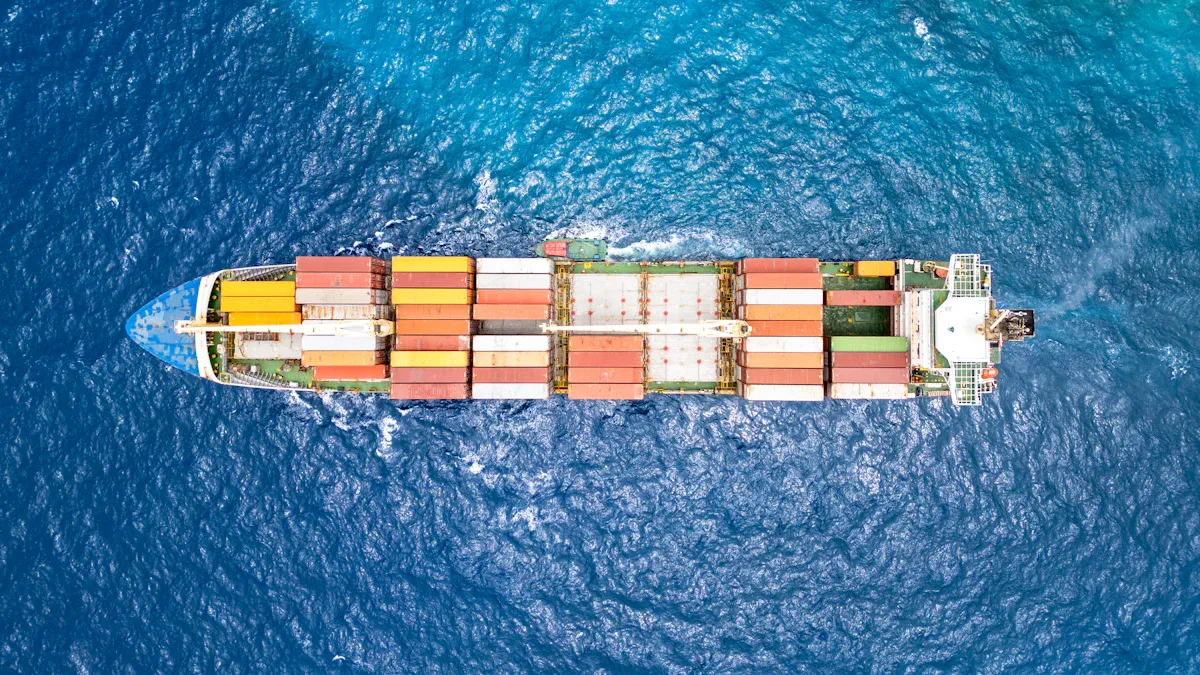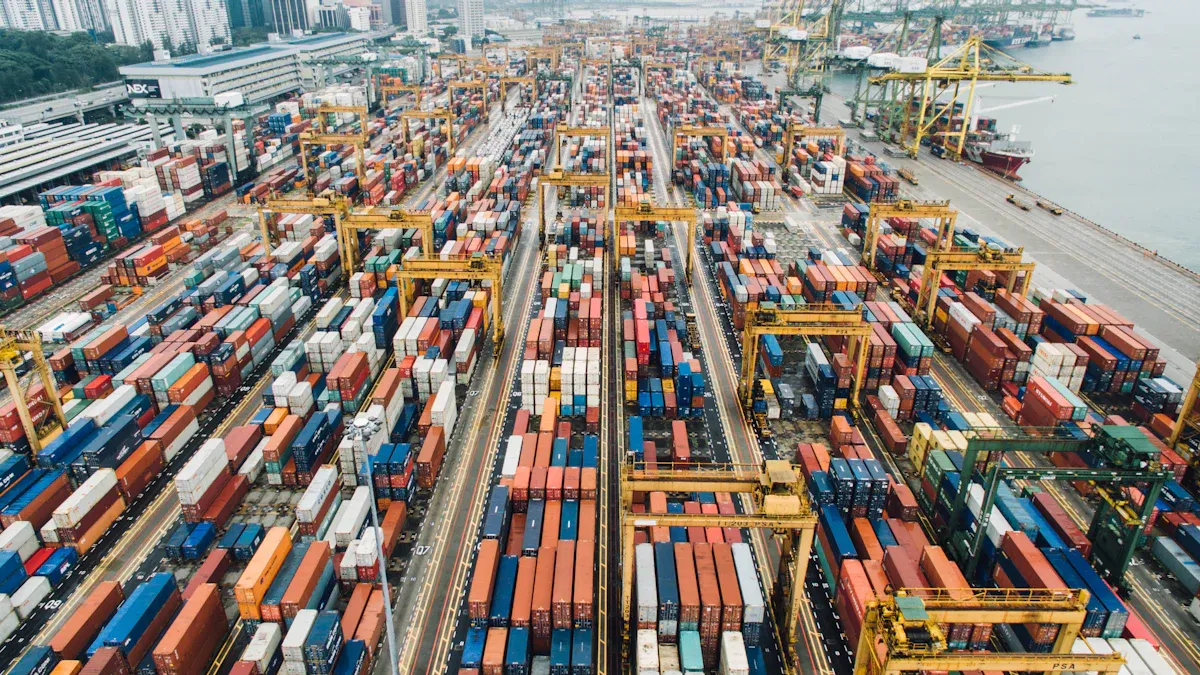What Is the Current Size of the Global Logistics Market

You might notice that the global logistics market size can look different depending on the source. Recent estimates show the market could reach $10.17 trillion in 2024, with some reports predicting a value between $8 trillion and $12 trillion each year. These differences often come from what sectors analysts include or how they measure costs. When you understand these numbers and premier global logistics market share insights, you can better spot trends, track competitor moves, and plan for business growth.
Market size estimates can shift based on:
Sectors and services included
Regional economic factors
Infrastructure costs
Key Takeaways
The global logistics market is projected to reach $10.17 trillion in 2024, with estimates varying between $8 trillion and $12 trillion.
Asia-Pacific leads in logistics growth, driven by technology and e-commerce, while North America and Europe also show strong markets.
Road freight is the largest sector, expected to grow significantly due to e-commerce and infrastructure improvements.
Understanding how market size estimates are calculated helps in making informed business decisions and spotting opportunities.
Future growth in logistics will focus on automation, sustainability, and improving last-mile delivery solutions.
Market Size

2023–2024 Estimates
You might wonder how big the logistics market really is right now. Different research firms report different numbers for 2023 and 2024. These differences come from how each firm collects and analyzes data. Here is a table that shows some of the latest estimates:
Research Firm | 2023 Market Size (USD Billion) | 2024 Market Size (USD Billion) |
|---|---|---|
Grand View Research | 3,931.8 | |
Market Data Forecast | N/A | 288.97 |
You can see that the numbers vary a lot. Grand View Research reports a much higher value than Market Data Forecast. This happens because each firm may include different sectors or use different methods. When you look at premier global logistics market share insights, you will notice that these differences can affect how you compare regions or plan your business.
Note: Always check which sectors and services a report includes before you use the numbers for planning.
Methodology Overview
You need to know how research firms calculate the size of the logistics market. The method they use can change the final number. Here is a table that explains the two main approaches:
Methodology Type | Description | Impact on Reported Figures |
|---|---|---|
Involves gathering data from primary sources to estimate market size. | Ensures estimates are based on detailed data analysis. | |
Top-Down Approach | Utilizes secondary sources to validate market size estimates. | Provides a broader perspective on market size through triangulation. |
Some reports use a bottom-up approach. They collect data from companies, shipments, and transactions. This method gives you a detailed view. Other reports use a top-down approach. They start with big-picture data and break it down into smaller parts. This method helps you see the overall market but may miss some details.
You should also pay attention to which sectors and activities are included in the calculations. Not every report counts the same things. Here is a quick overview:
Excluded Sectors/Activities | |
|---|---|
Agriculture | Live animals/fish |
Extraction | Cereal grains |
Utility | Other agricultural products |
Construction | Animal feed |
Service | Milled grain products |
Other sectors | Other foodstuffs |
Building stone | |
Natural sands | |
Gravel | |
Metallic ores | |
Coal | |
Crude petroleum | |
Gasoline | |
Fuel oils | |
Natural gas and other fossil products | |
Basic chemicals | |
Fertilizers | |
Chemical products | |
Plastics/rubber | |
Logs |
You can see that some sectors, like agriculture and construction, are usually included. Others, like live animals or crude petroleum, are often left out. This is why you see different numbers in different reports.
If you want to make smart decisions or compare premier global logistics market share insights, always check the details behind the numbers. This will help you understand the real size of the market and spot new opportunities.
By Region

You can see how the global logistics market breaks down by region. Each area has its own market size, growth rate, and unique trends. Here is a table that shows the latest available market size figures for major regions in 2024:
Region | 2024 Market Size (USD Billion) |
|---|---|
North America | 1,470.0 |
Europe | 782.8 |
Asia-Pacific | 1,380.3 |
Other Regions | Varies |
North America
North America stands out as a leader in logistics. The market size reaches USD 1.47 trillion in 2024. You can expect this figure to grow to USD 1.76 trillion by 2033. Growth remains steady, with a projected CAGR of 4.0% from 2024 to 2031. In recent years, the market recorded a historical CAGR of 3.5%. E-commerce drives much of this expansion. In the U.S., e-commerce grew at a CAGR of 7.6%, with penetration rising from 21.2% in 2022 to 22% in 2023. You can use premier global logistics market share insights to track how e-commerce shapes logistics in this region.
Market size: USD 1.47 trillion (2024)
Projected CAGR: 4.0% (2024–2031)
E-commerce growth: 7.6% CAGR in the U.S.
Europe
Europe’s logistics market is valued at USD 782.8 billion in 2024. You will see this market grow to USD 1,192.0 billion by 2030. The region expects a CAGR of 3.4% from 2025 to 2029. Europe’s growth rate is slightly lower than Asia-Pacific, but the market remains strong. You can observe steady expansion, especially in cross-border logistics and supply chain innovation.
Market size: USD 782.8 billion (2024)
Projected market size: USD 1,192.0 billion (2030)
Projected CAGR: 3.4% (2025–2029)
Asia-Pacific
Asia-Pacific shows rapid growth in logistics. The market size reaches USD 1,380.3 billion in 2024. You will notice a projected CAGR of 7.6% from 2025 to 2030. South Korea leads with the highest expected growth rate. Key drivers include infrastructure development, technology, increased trade, and the rise of e-commerce. Automation, AI, IoT, and blockchain also play major roles. Investment in transport corridors and intermodal facilities helps save time and costs.
Market size: USD 1,380.3 billion (2024)
Projected CAGR: 7.6% (2025–2030)
Leading country: South Korea (highest CAGR)
Other Regions
Other regions, such as Latin America, the Middle East, and Africa, show unique opportunities and challenges. The Middle East adapts to lower oil prices and invests in infrastructure. GCC countries upgrade facilities, which may challenge the UAE’s dominance. Latin America sees growth in cross-border logistics, led by Brazil and Mexico. E-commerce and improved ports support expansion, though road infrastructure remains a challenge. Africa’s ports become more important in global trade, but modernization and bottlenecks need attention.
Middle East: Resilience and investment potential, infrastructure upgrades
Latin America: Growth in cross-border logistics, e-commerce, port improvements
Africa: Strategic trade hub, increased container traffic, need for modernization
You can use premier global logistics market share insights to compare regions and spot new opportunities for your business.
By Sector
Road Freight
You will find that road freight is the largest part of the logistics market. It moves goods by trucks and vans across cities and countries. Here is a quick look at the latest numbers:
Metric | Value |
|---|---|
Projected Market Size | |
Compound Annual Growth Rate | 5.7% (2024 - 2034) |
Region with Largest Share | Asia-Pacific |
Several factors drive this growth:
E-commerce boosts demand for fast, small shipments.
New roads and highways make deliveries quicker and cheaper.
Green transport projects help companies cut emissions.
Full truckload shipping is popular for moving large loads over long distances.
You can use premier global logistics market share insights to see how these trends shape the future of road freight.
Air Freight
Air freight handles goods that need to move quickly, often across borders. The market was valued at USD 319.4 billion in 2024 and could reach about USD 492.7 billion by 2033. Growth is strong, with a CAGR of 4.9% from 2025 to 2033. E-commerce and the need for fast delivery help this sector grow. However, trade policies and global economic changes can slow it down. For example, new tariffs in the U.S. have reduced air cargo traffic, but trade between Asia and Europe is rising.
Maritime
Maritime logistics moves goods by sea. It is vital for global trade. The market size will reach USD 104.13 billion in 2025 and could double to USD 220.71 billion by 2035.
Year | Market Size (USD Billion) |
|---|---|
2025 | 104.13 |
2035 | 220.71 |
Growth comes from more global trade and new technology like AI and IoT. Challenges include high costs, strict rules, and supply chain disruptions.
Rail
Rail logistics is growing as a cost-effective and green choice. In 2024, the market size is about USD 416.8 billion. By 2034, it could reach USD 697.5 billion, with a CAGR of 5.4%. Rail is popular because it costs less and produces fewer emissions than road transport. Investments in new rail lines and digital tools help this sector grow, but old infrastructure can slow progress.
Warehousing & 3PL
Warehousing and third-party logistics (3PL) help store and manage goods for businesses. The global 3PL market is worth about USD 1.2 trillion in 2024 and could grow to over USD 2.2 trillion by 2033. This sector grows fast, with a CAGR of 7.01%. E-commerce, new technology, and the need for cold storage drive demand. Urban growth also pushes companies to build more warehouses close to customers.
Tip: If you want to spot which sectors are growing fastest, look at e-commerce, technology, and sustainability trends. These areas show up often in premier global logistics market share insights.
Premier Global Logistics Market Share Insights
Leading Regions & Sectors
You can see that certain regions and sectors stand out in the global logistics market. Asia-Pacific leads with rapid growth, driven by technology and infrastructure investments. North America follows with strong e-commerce and advanced supply chains. Europe remains important because of cross-border trade and innovation. When you look at sectors, road freight holds the largest share. Warehousing and third-party logistics (3PL) grow quickly as businesses need better storage and faster delivery. Air freight and maritime logistics also play key roles, especially for international shipments. You can use premier global logistics market share insights to compare how each region and sector performs.
Region | Leading Sector | Growth Driver |
|---|---|---|
Asia-Pacific | Road Freight | Technology, E-commerce |
North America | Warehousing & 3PL | E-commerce, Supply Chain |
Europe | Cross-border Logistics | Innovation, Trade |
Tip: You should track which regions invest in new technology and infrastructure. These areas often show the fastest growth in logistics.
Key Players
You will find that several companies shape the global logistics market. These leaders offer a wide range of services, from freight forwarding to supply chain management. You can use premier global logistics market share insights to see how these companies compete and expand.
DHL Supply Chain
DSV Panalpina
DB Schenker
Nippon Express
C.H. Robinson
XPO Logistics
UPS Supply Chain Solutions
J.B. Hunt Transport Services
Expeditors International
Each company brings unique strengths. DHL Supply Chain leads in global reach and innovation. DSV Panalpina and DB Schenker focus on integrated logistics solutions. Nippon Express and C.H. Robinson excel in freight forwarding. UPS Supply Chain Solutions and XPO Logistics offer advanced technology for tracking and delivery. J.B. Hunt Transport Services and Expeditors International provide strong transportation networks.
Note: You should watch how these key players invest in digital tools and sustainability. Their strategies often set new trends in the logistics industry.
Growth Trends
Historical Growth
You have seen the logistics market change a lot over the past decade. Technology has played a big role in this transformation. The internet and new information tools have made it easier to track shipments and manage inventory. Companies now use barcode scanning, GPS tracking, and RFID technology to keep goods moving smoothly. E-commerce has grown quickly, with platforms like Amazon and Alibaba leading the way. This growth has pushed logistics companies to improve last-mile delivery and focus more on customer experience.
Automation and robotics are now common in warehouses and sorting centers. You might notice robots picking and packing items or drones delivering packages. Artificial intelligence helps companies plan routes and predict demand. The industry also cares more about the environment. Many companies want to use greener practices and reduce pollution.
Over the last ten years, you have seen these trends shape the logistics market:
More digital technology
A bigger focus on customer experience
Growth in automation and robotics
Stronger push for sustainability
Drivers & Challenges
You will find several key drivers pushing the logistics market forward today. Technological advancements, such as AI, IoT, and blockchain, help companies work faster and smarter. Many businesses now use electric vehicles and look for ways to cut carbon emissions. Multimodal transport, which combines trucks, trains, ships, and planes, makes moving goods more efficient.
However, you also face some big challenges. Economic ups and downs and global tensions can make planning difficult. High logistics costs, especially in developing countries, slow down progress. There is a shortage of skilled workers, which makes it hard to use new technology. Supply chain disruptions, like those caused by global events, can stop goods from reaching their destinations.
You should watch these trends and challenges closely. They will shape how you plan and grow your logistics business in the future.
Outlook
2030–2034 Projections
You can expect the global logistics market to grow quickly over the next decade. Experts predict the market will reach $23.14 trillion by 2034. The market size will rise from $11.23 trillion in 2025. This growth means the market will expand at a compound annual growth rate (CAGR) of 8.36% from 2025 to 2034.
Several factors drive this strong growth. E-commerce keeps expanding. More people buy products online, so companies need better ways to move goods. Trade agreements between countries help businesses ship products faster and easier. Improvements in logistics infrastructure and technology also play a big role. You will see new warehouses, better roads, and smarter tracking systems.
Here is a summary of the projections:
Year | Market Size (USD Trillion) | CAGR (2025–2034) |
|---|---|---|
2025 | 11.23 | 8.36% |
2034 | 23.14 | 8.36% |
Tip: You should watch how technology and global trade shape the logistics market. These changes can help you plan for future growth.
Emerging Opportunities
You will find many new opportunities in logistics as the market grows. E-commerce creates demand for faster delivery and better last-mile solutions. Companies invest in automation, robotics, and artificial intelligence to make supply chains smarter. You can see more electric vehicles and green transport options as businesses focus on sustainability.
Here are some areas where you can spot new opportunities:
Urban logistics and last-mile delivery
Smart warehouses with robots and sensors
Digital platforms for tracking shipments
Green logistics and eco-friendly transport
Cross-border e-commerce and global trade
You can use these trends to guide your business decisions. If you follow technology and sustainability, you will stay ahead in the logistics industry. 🚚
You now know the global logistics market size stands near $10.17 trillion in 2024, though estimates range from $8 trillion to $12 trillion. Asia-Pacific leads growth, while North America and Europe remain strong. Road freight and warehousing show the largest shares. Technology, e-commerce, and sustainability drive change. Experts expect the market to reach $23.14 trillion by 2034. Use these insights to guide your business strategy and spot new investment opportunities.
Tip: Stay updated on market trends to make smarter decisions in logistics.
FAQ
What is included in the global logistics market size?
You will find that the global logistics market size covers road, air, sea, and rail transport. It also includes warehousing, third-party logistics (3PL), and supply chain services. Some reports may include extra sectors, so always check the details.
Why do market size estimates differ between sources?
You see different numbers because each source uses its own methods. Some include more sectors or regions. Others use different data collection techniques. Always review what each report counts before you compare numbers.
Which region grows fastest in logistics?
Asia-Pacific grows the fastest. You see strong investment in technology and infrastructure. E-commerce also drives rapid growth. Countries like South Korea and China lead this trend.
How does e-commerce affect logistics?
E-commerce increases demand for fast and reliable delivery. You see more warehouses, better tracking, and new last-mile solutions. Companies invest in technology to keep up with online shopping trends.
Who are the top logistics companies worldwide?
You will find leaders like DHL Supply Chain, DSV Panalpina, DB Schenker, and UPS Supply Chain Solutions. These companies offer global services and invest in new technology to stay ahead.
See Also
Trends in Logistics That Will Define Tomorrow's Industry
Key Strategies for Effective Global Logistics Operations
Core Elements of Best Practices in Global Logistics
